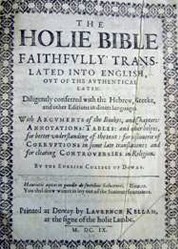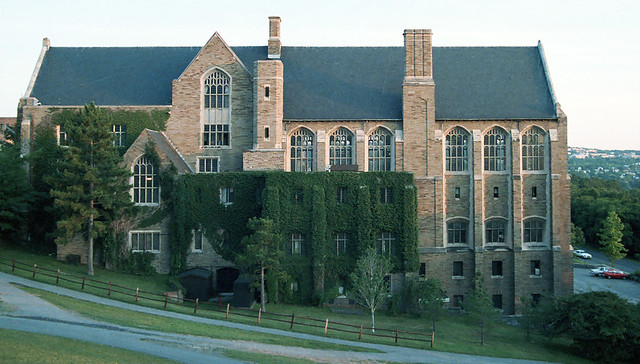"There are only two books worth reading on the Traddie situation," a correspondent, who knows who he is, wrote me to over a year ago. "Dr. Hull's book and Undermining of the Catholic Church by Mary Ball Martinez."
Traditionalists and all stripes of Catholics have access to volumes upon volumes of material to read, published or online. The best sources are of course Scripture, the liturgical texts of the Church, and the Fathers. These sources tell us not just what to believe, but more importantly how to believe. And there are other useful books, works, and lecture series for understanding theology, liturgy, history, and philosophy. Many of these works have been reviewed on this blog, particularly ones pertaining to liturgy (Dr. Hull's book, Kavanagh's lectures, and Laurence Hemming's works among them). And yet after extensive reading and private research I must agree that, as far as the "Traddie situation" is concerned—the 20th century revolution in the liturgy and the political agenda of the Roman Church—The Banished Heart by Geoffrey Hull and Undermining of the Catholic Church by Mary Ball-Martinez are still the best books to read. Other books touch related material, but only these works address the matters at hand directly.
I have
alluded to Martinez's first book,
From Rome Urgently, which was a compilation of articles she wrote in the 1970s.
Undermining is something of a sequel to
From Rome, with greater and clearer rumination on the status of the traditionalist movement and limpid hindsight into the beginnings of the revolution in the late 19th century.
Undermining, which can be read and downloaded free of cost
here,
has largely been ignored by all quarters of the Church because its thesis and narrative do not fit anyone's agenda. The liberal crowd may have agreed with its facts and found the result of the revolution positively delightful. The neo-Ultramontanists who we now identify colloquially as the "JP2 generation" would find the criticism of the renewal outright scandalous. And sedevacantists, FSSPX traditionalists, and "indult" traditionalists could not stomach that she exposed Pius XII and the early 20th century Vatican for what they really were. Consequently, her book enjoys a dedicated, narrow following like 1980s "B films."
The Thesis
Martinez's begins on the vigil of Pentecost in Rome in 1971. The Second Vatican Council closed six years earlier. Pope Paul was midway to the end of his tragic reign. Archbishop Lefebvre was not yet ready to declare himself publicly. And Catholics were gathered and praying the rosary by the thousands under the windows of the Apostolic Palace for the return of the old Mass. How did the Church arrive at this odd point? With Mystici Corporis, Martinez says. MC was the first and most vital step in dismantling the legalistic understanding of the Church that dominated the Counter-Reformation and replacing it with a model based on human beings, an opinion shared by Avery Dulles, the Jesuit Cardinal and theologian. It was the first domino to fall, culminating in the long anticipated Council that would complete a revolution started in 1903.
In 1903, Martinez asserts, Cardinal Rampolla was elected or nearly elected Pope, only to be vetoed by the Polish cardinal under the auspices of an obscure and long forgotten treaty. The cardinals then flocked to the patriarch of Venice, whose first decision as Pope was to rescind all veto privileges. Rampolla, now saddled with the less glamorous position of Secretary of the Holy Office, spent his time training three proteges who would make his humanistic vision for the Church a reality: Giacomo della Chiesa, Pietro Gasparri, and Eugenio Pacelli. Della Chiesa had no sooner been made a cardinal than he was elected Pope Benedict XV and began to undo his predecessor's measures against modernizations, including the dissolution of Pius X's secret informant network. The First World War threw a wrench into the clique's immediate plans. When Benedict XV died prematurely the powers that were found themselves in a debacle. Pacelli was still too young and Gasparri was un-electable. As a solution they elected an aloof academic in Pius XI, hitherto the Vatican Archivist. It was during this papacy that things began to turn.
The Secretariat of State office, run by Gasparri and assisted by Pacelli, promoted policy antipodal to the teachings and desires of the Pope of the time, opposing and undermining Action Francaise and the Catholics in the Spanish Civil War in favor of French secularists at the same time the Pope was talking about the "social reign of Christ the King," a long favorite subject of traditionalists. The most reprehensible betrayal was that of the Christeros, wherein a civilian army fighting against a humanistic and even Masonic (?) president in Calles with no support from the upper clergy achieved absolute victory and were then convinced by Rome to make an un-conditional surrender and subject themselves to slaughter.
During this same period the paradigm shifted within academia and the religious orders, often with tension between the younger and older generations of priests. The Holy See, far from reigning in excesses and deviations from the accepted teachings and outlook, often aided and abetted these digressions. In the case of Teilhard de Chardin the Society of Jesus prohibited him from publishing and obstructed him from going on the speaking circuit. The Secretariat of State however, at the behest of Pius XII, arranged for him to give lectures in occupied France during the rule of the Vichy government.
During the War Pius XII aided Jewish efforts to escape from the Holocaust and Hitler's death camps, but almost entirely ignored the political difficulties of the Church during this era. His foreign policy consistently stood against authoritarian governments that were either indifferent to Catholicism or in favor of it, but he sided with the humanists and Marxists. He permitted the Vatican to be used an an intermediary point in the War for discussions between the Allies. And he spent copious time during the War smuggling Jews from Italy into British Palestine on the eastern coast of the Mediterranean. After the War the early seeds of liberation theology and the Charismatic movement began to sprout above ground with the support of Countess Pacelli, the Pope's sister.
The time after the War was spent consolidating power and loosening discipline. The Biblicum was created in Rome to give a presence in Vatican academia to the progressive movement. The rules around the celebration of Mass and reception of Communion were relaxed to a point envied today, but risible to previous generations. And the promulgation of the dogma of the Assumption and the creation of a commission to reform the liturgy centralized spiritual authority around the Pope. Martinez at one point boldly asserts that the canonization of Pius X was part of a barter with the baroque-minded Vatican establishment to begin introducing the new liturgy, particularly the new rites of Holy Week.
Aware of his age, the Pope sent his protege to Milan, but died before making his successor a cardinal. The affable Angelo Roncalli took the papacy for a few years before Montini could become Pope in 1963. From that point on the narrative becomes familiar. We all know about the Council, the branching and flowers of the roots planted half a century earlier.
The middle section of Undermining is a series of vignettes, short biographies of the Popes from John XXIII until the then-incumbent John Paul II. Paul VI's segment is especially poignant. He was an early revolutionary, encouraging students in the Red Brigade to oppose Mussolini, who, although a bad man, was tolerant to the Church in ways unseen since before the 1840s. Later in life he may have lamented that the Red Brigade had killed his dear friend Aldo Moro, the product of the center-left political party his father had party and Pius XII advanced decades prior. He died a broken, unhappy man. Also interesting, if only for historical reasons, is her honest biography of John Paul II. She summarizes his education and seminary formation in Poland after the Russian invasion and his time at the Belgian college in Rome dispassionately and with concision. This was revolutionary in 1991 because most people were pretending he was an impoverished miner who studied at an underground seminary amid Soviet persecution.
The last segment of the book contrasts sharply in certain aspects with From Rome Urgently. Previously she was brimming with excitement about Lefebvre, the militancy of the traditionalists, and the devotion of the faithful. She maintains these qualities in Undermining, but with considerable reservation. She wonders if Lefebvre missed his chance to make a difference in 1976 by obeying the Pope's command to bite his French tongue. The grassroots traditionalist movement collapsed and all that was left was the FSSPX and a few independents—something that will be explored in our upcoming series on the early traditionalists.
Short-Comings
Undermining is not a book without short-comings, the three greatest of which are: the lack of citations, the proclivity for conspiracy-theory language, and a lack of historical perspective.
The lack of citations is the most arrant deficiency in this work. Martinez was a journalist, writing for decades as the Vatican correspondent for National Review, the Wanderer, and other periodicals. She was not a professional historian and did not document her work very well. Much of what she learned could be documented with extensive and painful research though. I came to trust Undermining from personal experience. My first major university research project was on the role of the Holy See during the Second World War. What Martinez surmises about the Pope's efforts against the Nazis and Holocaust I corroborated independently years before encountering her book using primary information sources (journals, news articles, and records) as well as some scholarly polemics. That she recorded this information favorable to Pius XII during a time before a cottage industry for defending his War record emerged (Rabbi Dalin, Sr. Marchione etc) and given her un-favorable view of the man impressed me.
The second issue is also significant. She speaks of "the Masons" and like groups as though they are an organized secret government with a dedicated head—as though the cretins who mangled the Church in the 20th century and who are mangling Western governments and economic policy now are capable of such things. She does at points clarify what she means, but often lapses into conspiracy theories again. At one point she wrote that Pius XII, Paul VI, and Benedict XV should not be considered conspirators in the common understanding of the word. These men did not hold round tables discussions on how to undermine the Church deep within the walls of a lodge. These men acted in accordance with their rearing and education, which involved a different outlook on the Church than the one received. She does claim John XXIII and Pius IX (you read that right) were Masons, but does not expound upon the supposed significance of this too deeply.
The last pitfall is her lack of perspective. Mystici Corporis was a departure from the legalistic, cold understanding and corporate structure of the Catholic Church that emerged during the Counter-Reformation. Where she errs is in stating that the teaching was entirely novel. Indeed, it is well rooted in the letters of St. Paul, the sermons and treatises of the Cappadocian Fathers, and in the ecclesiology of Lateran IV. The footnotes and citations in MC easily verify this. Where she was right was in suggesting that the point of MC was to confuse theologians by introducing an understanding of the Church based on human beings and mysticism. Indeed, the idea of the Church as the Body of Christ bound up in the Sacraments is the teaching of the Church Fathers East and West as well as that of the Greek and Latin liturgies. The idea of the mystical Body of Christ was quite novel, and the focal point of this mystical body would be the Roman Pontiff. Martinez, with more familiarity with the deeper traditions of the Church, might have realized that MC was about spiritual centralization and taming precocious revolutionaries, not about introducing unheard of doctrines.
Final Words
Undermining of the Catholic Church by Mary Ball-Martinez is an essential work to study and parse for those who seek to understand the political changes in the Vatican that wrought decades of internal revolution in the Church of Rome. For all its problems, Undermining is the only book that connects the dots which have been hiding in the plain sight of traditionalists for years.
As an aside, if anyone wants to know how to access her first book, From Rome Urgently, email me.
UPDATE: My email address is theradtrad@gmail.com.








.jpg)


.JPG)






















